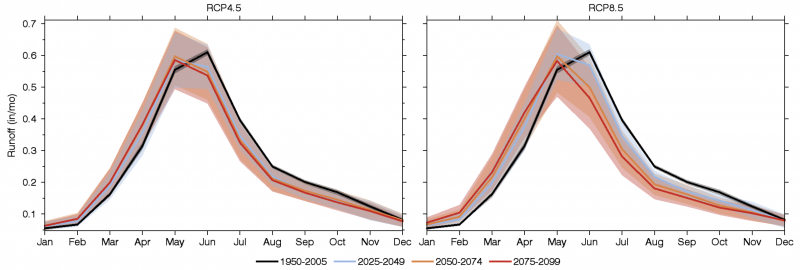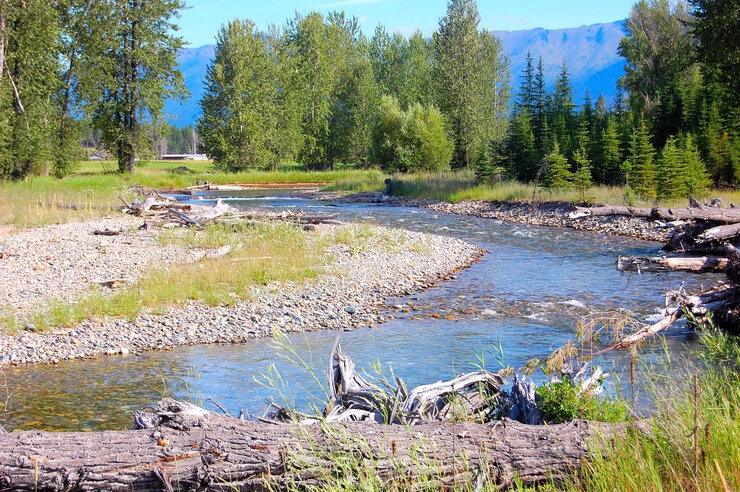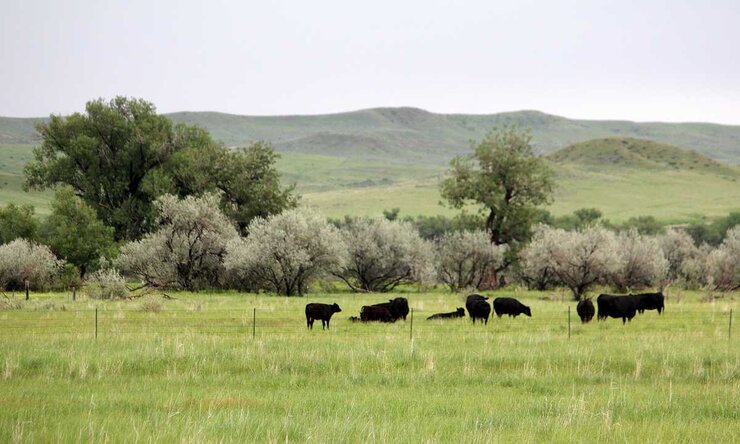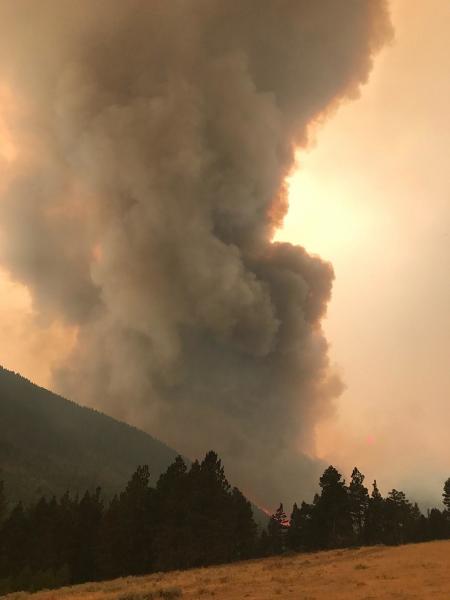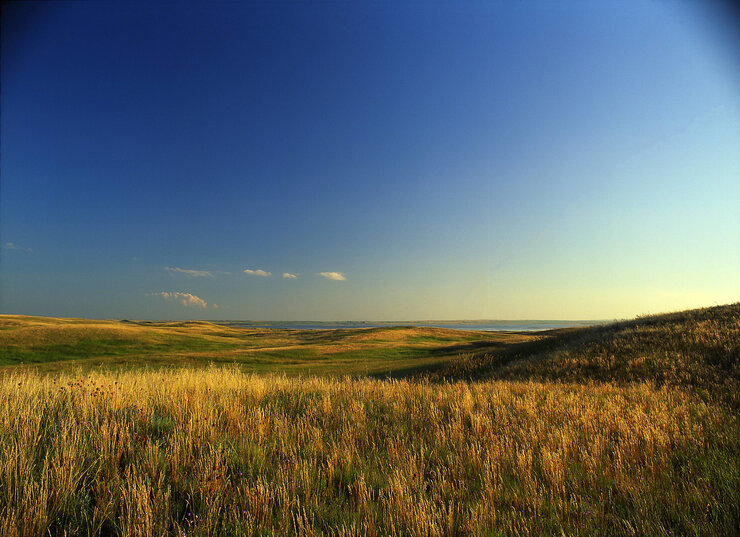Monthly averages of runoff across the Missouri River Basin for four time periods for the RCP4.5 (left) and RCP 8.5 (right) emission scenarios based on 30 CMIP5 global climate model projections. Solid lines indicate average values and shaded envelopes indicate standard deviations. These results indicate earlier peak runoff, increases in runoff volume between January and May, and decreases in runoff volume between June and November. Click on the image for more information.
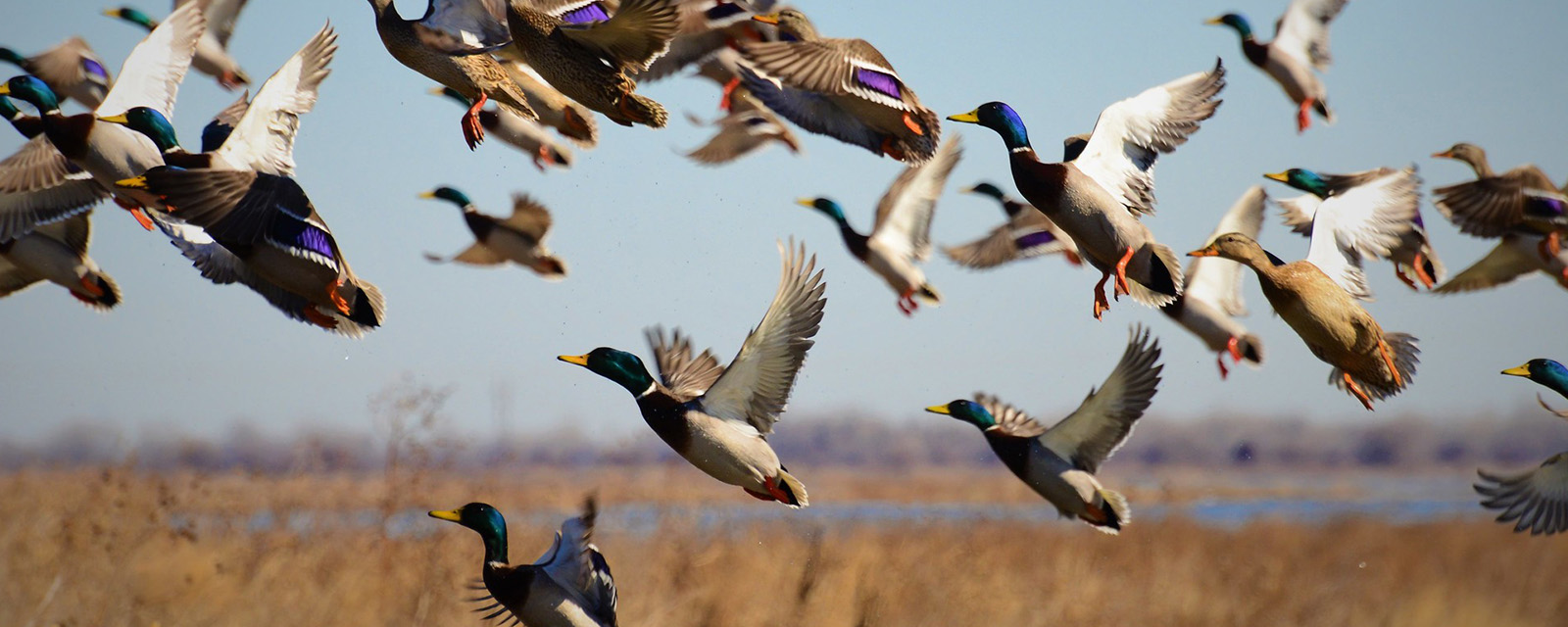

Ecosystems and Biodiversity
Key Points:
- Warmer and generally wetter conditions coupled with elevated atmospheric CO2 will impact seasonal water availability, and plant phenology and physiological responses.
- Wildfire, pathogens, and human disturbances will diminish habitat quality in all ecosystems.
- Adaptation will require a better understanding of plausible ecological responses to climate change and other stressors, and increased flexibility in decision making.
- Some areas that have already been heavily impacted by climate change could be beyond recovery. Managers should be ready to use a science-based triage approach to biodiversity conservation.
- Adaptation strategies could increase ecosystem and biodiversity resilience to climate change.
Climate change-driven ecological impacts
Climate change is expected to cause significant changes in regional streamflow patterns, including higher high flows and lower low flows, or greater fluctuations in flows across seasons and years. In addition, a greater incidence of extreme rainfall events and rain-over-snow events is expected to increase flash flood risks.
Warming will reduce the extent and seasonality of snowfall and ground snow cover, which could influence phenological responses—periodic biological responses, such as plant flowering or bird migration—in plants and animals, pose novel extreme climate hazards, and change the pattern of growing-season moisture availability to plants. Increased heat stress from a warmer climate will negatively affect plant and animal health. Warmer stream temperatures and lower streamflow will potentially increase the toxicity of contaminants to aquatic plants and animals.
Biological impacts of concern to aquatic and land-based habitats include declines in some key habitats (e.g., for cold-water fish such as cutthroat trout), geographic shifts in the distribution of suitable habitat for some species (generally moving upstream, upslope, and poleward), and phenological shifts that could result in mismatches in habitat quality and wildlife activity.
Other important indirect climate stressors on biodiversity and habitat quality include increases in the presence and abundance of invasive species and new pathogens and disease vectors. Changing climatic conditions are expected to favor invading non-native species over plant and animal life native to a site or a region. Increases in the frequency and intensity of extreme weather events, in particular, could accelerate species invasion by putting native species at a competitive disadvantage. Similarly, pests and diseases are expected to expand or shift their ranges as the climate warms and could contribute to large-scale disease and death in plants or animals. These relationships and interactions are complex, and require further research to allow us to better understand responses. Overall, climate change-induced decline in biodiversity is expected to promote less varied populations, which could result in increased competition and contribute to local extinctions and reduced community resilience.
Climate change is also increasing the frequency and severity of wildfires. Warmer temperatures are causing record dry conditions that are promoting rapid fire spread and severe burns on a much larger scale than during the last century. Even recently burnt sites are experiencing recurrence of severe wildfire activity. This changing nature of wildfire could significantly impact ecosystem functioning, community composition, and habitat quality. There are also amplifying feedbacks between wildfire and invasive species.1 For example, increased cheatgrass invasion in sage habitat in southwestern Montana leads to hotter fires and slower recovery of sage.
The direct effects of climate change on ecosystems discussed above are expected to cause large-scale ecological disturbances and lead to transformation of ecosystems to different and new groupings of species—a process that could be irreversible, at least in the short term. One of our biggest challenges is not knowing in many cases how (and when) species or ecosystems will respond under different scenarios of climate change.
In addition to the direct effects of climate change on fish and wildlife and their habitats, it is also important to consider the “wild card” of how humans are responding, and will respond, to climate change. For example, climate change is likely to alter the timing and amount of water needed for irrigation of agricultural fields, which could further limit water availability for fish, wildlife, and plants and increase contaminant toxicity. Earlier starts to growing seasons, or earlier starts to the water-stressed period of the growing season that are not accounted for by ranchers in adjusting their grazing schedules to fit the new conditions, may favor invasive winter annual grasses (like cheatgrass) or stress native species. Land-use change (particularly from grasslands to agriculture) may also have severe negative impacts on pollinators.
The Prairie Pothole Region of the Northern Great Plains, which provides important wetland habitat for the majority of waterfowl hatch in North America, has experienced warming and a sustained multi-decadal wet (high precipitation) period in recent decades. This prolonged wetness has created a positive response to migratory bird habitat, but land-use change and disproportionate drainage of small wetlands are creating homogenization in wetland hydroperiods (the period when soils are waterlogged) and increases in wetland size. The lack of a mixed habitat and losses in upland grasslands can have negative impacts on the future quality of prairie-pothole wetlands as migratory bird habitat. Future climate warming and increased precipitation variability are projected to decrease the number of ponded wetlands during migratory bird breeding season, but are expected to have a more limited influence on the distribution of ponded wetlands.2
Climate adaptation strategies
In a climate adaptation planning workshop held by Wyoming’s Game and Fish Department to inform the 2020 Statewide Habitat Plan, some key strategies that were identified for managing river, riparian, and wetland habitats included:3
- Managing land and water use with an eye towards future conditions.
- Building watershed health and resilience to a changing climate; for example, using process-based restoration techniques.
- Maintaining species diversity and habitat needs in a changing climate.
- Making climate-informed decisions about angling, trapping, and setting goals for habitat management areas.
- Prioritizing habitat management efforts using a climate change lens.
- Establishing and implementing research and monitoring that can help to anticipate changes and set climate-informed priorities.
Natural resource managers have traditionally focused on maintaining or restoring ecosystems to prevailing conditions over the historical period (i.e., the past ~100 years), but these goals and strategies may no longer be appropriate under a rapidly changing climate and the ecological responses that result. A central challenge that resource managers face in preparing for and responding to these profound changes is the uncertainty in future climate change and ecological impacts, among other factors.
Managers will have to be highly adaptive, and proactively and continually refine their approaches to emerging and anticipated impacts of climate change. In addition to responding to the changing climate and ecosystem characteristics, managers will also need flexibility to adapt to changing societal demands and to navigate new and obsolete policies. Adaptive management (i.e., learning through management and refining management strategy accordingly) is one tool that can give managers flexibility in responding to both anticipated and new impacts.4
A number of other forward-looking conservation planning approaches can facilitate the incorporation of uncertainty in future climate change and other stressors and associated ecological responses into resource management planning (see the box below). These approaches have been developed or adopted from other arenas to help natural resource managers understand system vulnerabilities and make informed and value-based decisions that account for uncertainty. These include approaches such as Scenario Planning, Structured Decision Making, the Climate-Smart Conservation Cycle, and the Adaptation for Conservation Targets (ACT) framework. Another decision-making framework that has emerged over the past decade is Resist-Accept-Direct (RAD), which is promoted as a simple, complementary approach to consider the entire decision space in responding to strong human-influenced ecological trajectories and the prospect of rapid and irreversible change.
Adaptation Resources for Natural Resource Managers
- Adaptive Management
- NIACS Climate Change Response Framework
- U.S. Forest Service Climate Change Resource Center compendium of climate adaptation strategies
- Scenario Planning | The National Park Service (NPS) and the U.S. Geological Survey have been developing approaches for incorporating uncertainty in future climate change and its impacts into NPS management planning processes through scenario planning. This has resulted in park-level adaptation in the Northern Great Plains (Devils Tower, Badlands, Knife River, and Wind Cave).
- Prescribed burning and other fuel reduction activities to reduce risk of severe wildfires
- Climate-Smart Conservation: Putting Adaptation Principles into Practice
- The Adaptation for Conservation Targets (ACT) Framework: A Tool for Incorporating Climate Change into Natural Resource Management
- Resist-Accept-Direct (RAD) Framework
- Wildlife Conservation Society Climate Adaptation Fund | Supported projects provide examples of climate adaptation implementation projects for wildlife and ecosystem conservation
- National Park Service Adaptation Resources | Provides examples of successful climate adaptation projects implemented within national park units
In recent times, there has been an emphasis on identifying, protecting, and enhancing the resilience and resistance of ecosystems and ecosystem processes across a landscape. These approaches include understanding and establishing (or reestablishing) habitat connectivity across terrestrial and freshwater ecosystems, to allow species to track optimal climate and habitat conditions. They also include identifying and protecting climate refugia—an area of relatively unaltered climate—to protect native species in the short term, and provide havens for biodiversity and ecosystem functions in the longer term. Other more active approaches include limiting the spread of invasive species to maintain biodiversity and promote ecosystem function and resilience to climate change, and conducting genetic rescue, where introduction of genetic diversity enhances fitness in small and dwindling populations. In forested systems, the management of stand density, surface fuel reduction, control of invasive species, and aquatic habitat restoration assist in increasing the whole system’s resilience to the direct and indirect effects of climate change.
The concept of enhancing resilience to resist trajectories of change can work alongside the acceptance or direction of transformative changes as complementary approaches that can be applied strategically across the landscape or sequentially in one place over time, as climate change and its impacts intensify and the costs of resistance mount. Approaches that aim to accept transformational change could include restoring corridors that allow wildlife to move within and between areas that offer a diversity of microclimate niches, so that species can seek suitable climate and habitat conditions as they shift across the landscape. Directing change could involve managed relocation of threatened species to areas that are expected to remain or become suitable in the future, or it might involve revising plant restoration mixes to include species or genotypes that are projected to thrive under future climate conditions or seeds sourced from areas that better reflect projected future climate conditions.5
Finally, it should be acknowledged that resources available for conservation are limited and the scale of the problem is significant and growing. The available resources should therefore be used more strategically for conservation. Managers should be ready to make hard decisions and use sound science towards making choices on where to put the limited resources, based on an increased likelihood for either recovery, persistence, or transition to a new acceptable state.
The preceding text was exerpted and adapted from the Fourth National Climate Assessment, Chapter 6: Forests, Chapter 7: Ecosystems, Ecosystem Services, and Biodiversity, Chapter 22: Northern Great Plains, and Chapter 28: Reducing Risks Through Adaptation Actions.
To learn more about climate impacts on ecosystems and species, and adaptation efforts therefore, visit the Ecosystems topic.
- 1. Taylor, K., T. Brummer, L.J. Rew, M. Lavin, and B.D. Maxwell, 2014. "Bromus tectorum response to fire varies with climate conditions." Ecosystems 17(6), pp. 960–973.
- 2. McKenna, O.P., D.M. Mushet, S.R Kucia, and E.C. McCulloch-Huseby, 2021. "Limited shifts in the distribution of migratory bird breeding habitat density in response to future changes in climate." Ecological Applications, https://doi.org/10.1002/eap.2428.
- 3. Cross, M., P. Dey, I. Tator, R. Bredehoft, A. Mahoney, N. Smith, and J. Waseen, 2020. Climate Change & Management of River, Riparian and Wetland Habitats in Wyoming: Summary from Wyoming Game and Fish Department Climate Change Workshop - April 28-30, 2020 (PDF).
- 4. Williams, B.K., 2011. "Adaptive management of natural resources—framework and issues." Journal of Environmental Management, 92(5), pp. 1346–1353.
- 5. Schuurman, G.W., C. Hawkins Hoffman, D.N. Cole, D.J. Lawrence, J.M. Morton, D.R. Magness, A.E. Cravens, S. Covington, R. O’Malley, and N.A. Fisichelli, 2020. "Resist-accept-direct (RAD)—a framework for the 21st-century natural resource manager." Natural Resource Report NPS/NRSS/CCRP/NRR—2020/ 2213. National Park Service, Fort Collins, Colorado.

